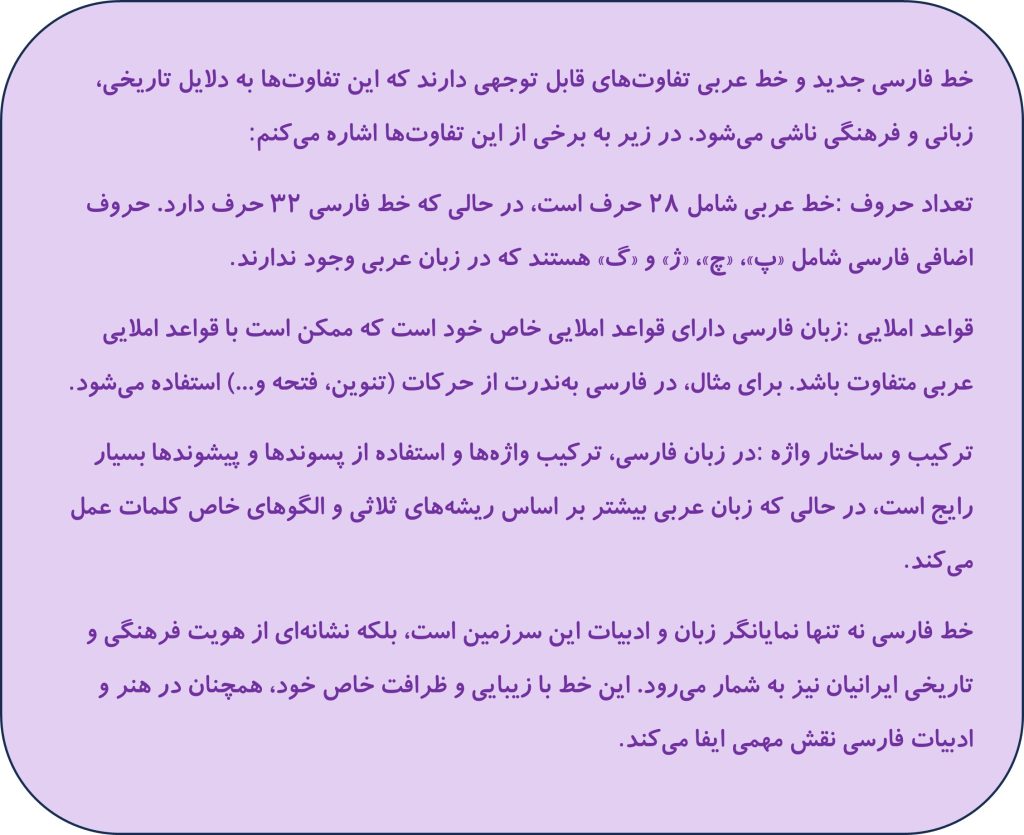The History of the Persian Language


Persian is also known as Farsi. In Afghanistan, the Persian language is officially called Dari, and in Tajikistan it is called Tajiki. The word “Farsi” is the Arabized version of the word “Parsi”. The Persian language is known in the world as “Persian” or “Persia”.
The Persian language was the language of a large part of West and South Asia from around 1000 AD to 1800 AD. Persian is an Indo-European language, belonging to the Indo-Iranian branch of the Iranian language family. The origins of the Persian language can be traced back to ancient Iran.
The historical evolution of the Persian language is divided into three periods: Old, Middle, and New. Persian is the only Iranian language that has records of all three historical periods, with texts remaining from each period. The language originated from the dialects of the Pars people, and with the rise of the Achaemenid dynasty, it spread across the vast territories of the Iranian plateau and surrounding regions.
Persian has a symmetric and balanced sound system, and its simple and effective structure has shed the irregularities and complexities of the earlier stages, to the benefit of its practical usage.

Various dialects of the Persian Language

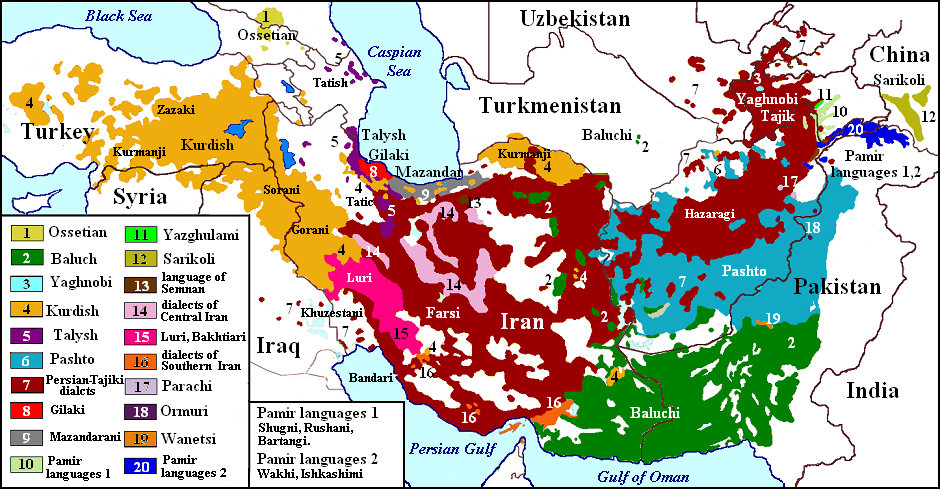
1- Bakhtiari and Lori: This is one of the dialects spoken by the people of southwestern Iran. Although Lori and Bakhtiari have differences, they are usually classified in the same group.

2- Kurdish: The Kurdish language is the language of the people living in western Iran, part of which is in Iran and the other part in Turkey and Iraq. In our country, Iran, the people of the provinces of Ilam, Hamadan, Kermanshah, Kurdistan, North Khorasan and West Azerbaijan speak this dialect. The Kurdish dialect has different accents, the most common of which are Hawrami, Laki, Kurmanji, Sorani, Kalhari, Gorani and Kermanshahi. Sorani and Kurmanji accents are among the most common Kurdish dialects.

3- Balochi: This is one of the oldest Persian dialects, which was the dialect of the inhabitants of northwestern Iran, but today most Baloch people live in southeastern Iran.

4- Taleshi: This dialect is more common in the northern regions of Iran, in the provinces of Gilan (Namin city), Ardabil and Astara. This dialect has different accents, for example, in the north of Talesh, there are 5 accents of Astara, Lankaran, Masali, Lorbaki and Ambarani.

5- Gilaki: This dialect is more common in Gilan and Deilaman, and the people of Gilan still use it in their speech. This dialect has the accents of Bieeposi or West Gilan, Biepishi or East Gilan, and Galeshi. The number of people who speak this dialect is more than one million.

6- Tabari or Mazandarani: This dialect is common in most parts and cities and villages of Mazandaran province and also in some western parts of Golestan province such as Aliabad Katoul, Kordkoy and Bandar-e Gaz. In addition, some eastern and northern parts of Tehran province such as Firuzkuh, Damavand and Rudbar-e Qasran, as well as some cities of Semnan province such as Chashmeh and Shahmirzad, also speak this accent. This dialect has differences in vocabulary and pronunciation in mountainous cities and regions.
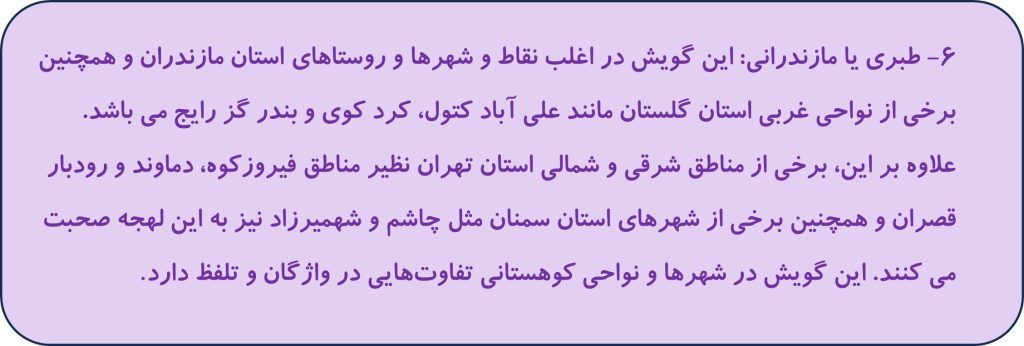
7- Lari: A dialect that is mostly used in the southern provinces of Iran, including Fars and Hormozgan.

8- Dialects of central Iran: In some villages in these regions, there are dialects that have not yet disappeared and are used by a few people. Unfortunately, little research has been done on them. Some of these dialects are: Yazdi, Naini and Anaraki, Natanzi, Yarandi, Farzandi, Khuri, Mehrjani.
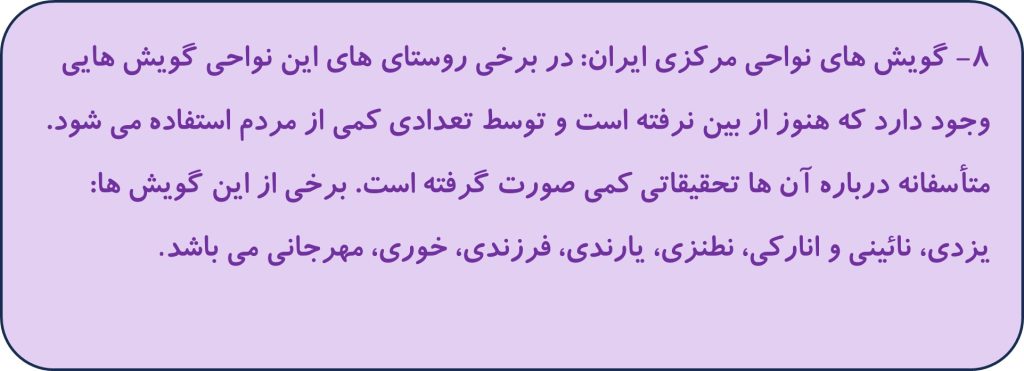
The History of the Persian Script

The history of writing in ancient Iran reaches back approximately five to seven thousand years, according to an inscription discovered in southern Iran. For example, one can refer to the inscriptions found in the three-thousand-five-hundred-year-old Ziggurat temple. However, since our evidence in this regard is not complete, we will refrain from mentioning the languages and scripts prior to the Achaemenid period.
Below, we outline the main stages of the history of the Persian script:
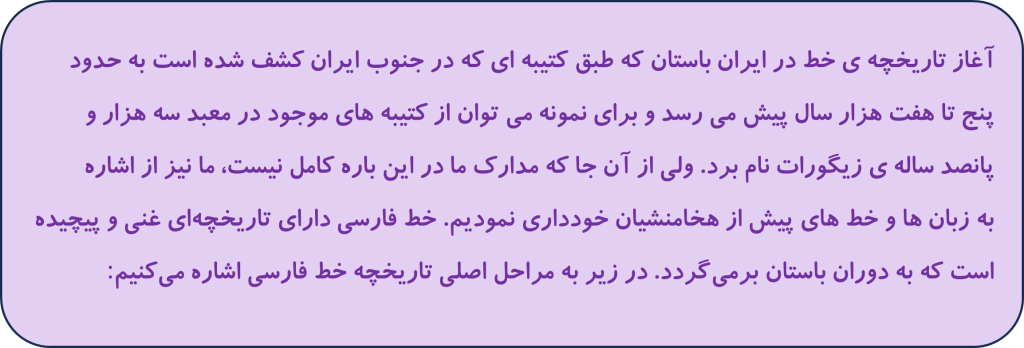
1. Cuneiform Script
The inscriptions from the Achaemenid era (approximately 550 to 330 BCE) are written in cuneiform script. The Iranians adopted this script from the Chaldeans and Assyrians, making modifications to create an alphabetic form. This script, written from left to right, consisted of 36 characters and was used for carving and writing on stone and hard surfaces. Due to the difficulty of writing in this script, it began to decline during the Parthian period and gradually became obsolete.
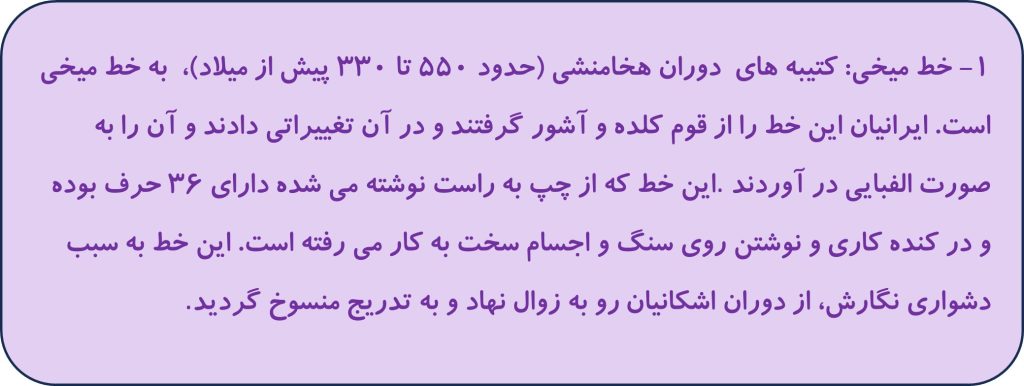
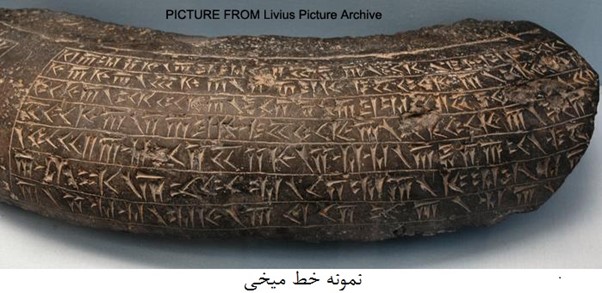
2. Pahlavi Script
After the fall of the Achaemenids, the Pahlavi script was used as the official script during the Sassanian period (224 to 651 CE). This script included several different forms and was mainly used for writing religious and literary texts.
The Pahlavi script, which was written with separate and disconnected letters from right to left, was derived from Aramaic. During the Achaemenid period, this script was used for writing, while cuneiform was used for inscriptions and carvings. In the Parthian era, the Pahlavi script became common for both inscriptions and carvings. The Pahlavi script consists of 25 letters, and one of its major drawbacks is that it lacks vowel letters, with one letter sometimes representing multiple sounds.
Numerous works remain from the Sassanian Pahlavi, mainly consisting of religious, ethical, literary, and narrative texts. The Pahlavi script was common during the Sassanian period and remained in use in Iran for about a century after the advent of Islam. After the Arabic script replaced it, the Pahlavi script continued to be used for correspondence and religious texts among some Iranians, especially the Zoroastrian priests.
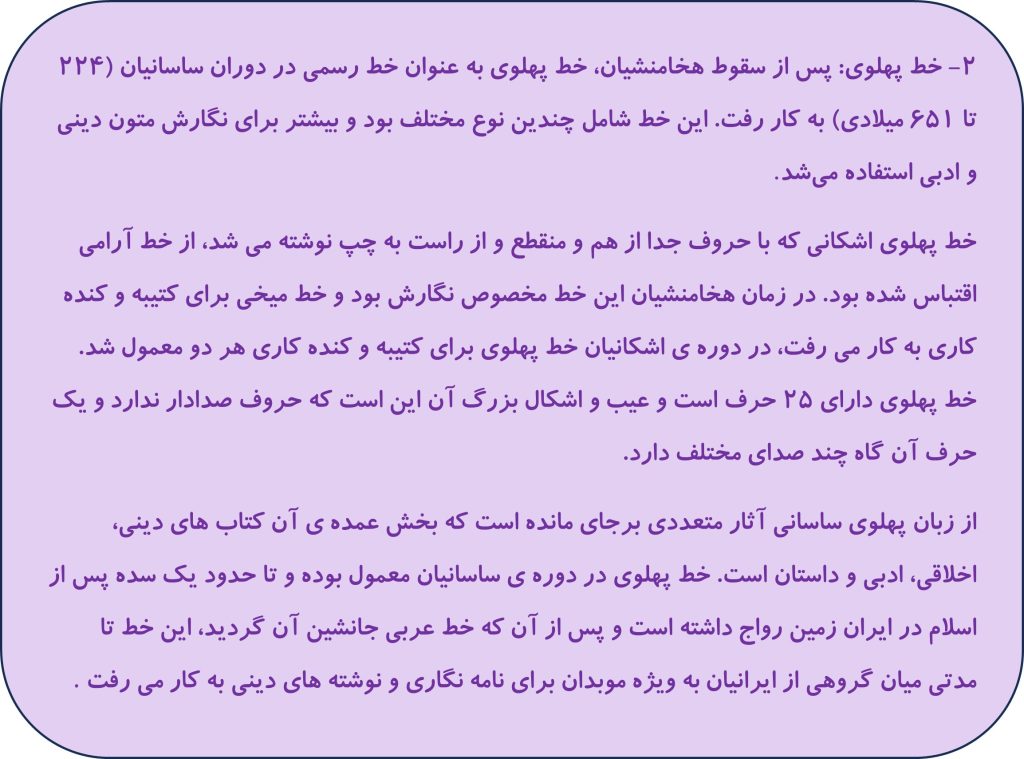
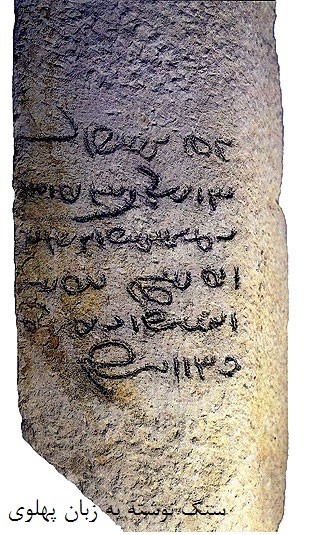
3. Arabic Script
With the arrival of Islam in Iran in the seventh century CE, the Arabic script was introduced as the official script. Iranians adapted the Arabic script to meet their linguistic needs, adding letters to accommodate the Persian language.

4. Modern Persian Script
Today, the Persian script is a combination of features from both Arabic and Persian scripts and is officially used in countries where Persian is spoken.
The Pahlavi script shares principles with the modern Persian script; this similarity is not coincidental but rather stems from the fact that both originated from the same language. Middle Persian scripts were derived from Aramaic, which itself has Semitic roots, while the modern Persian script evolved from the Arabic Kufic script with slight and superficial changes. The Arabic script is also categorized as a Semitic script.
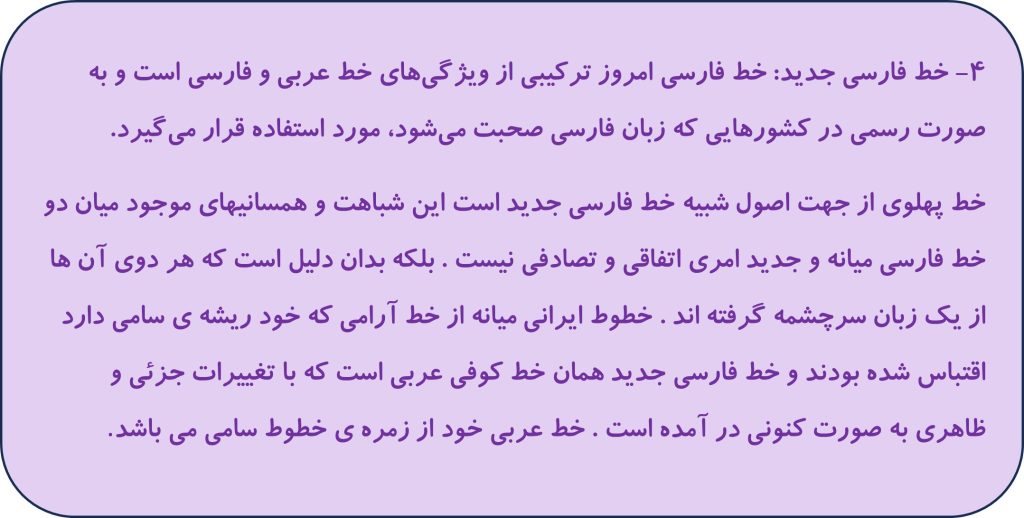
Modern Persian script and Arabic script have significant differences resulting from historical, linguistic, and cultural reasons. Here are some of these differences:
- Number of Letters: The Arabic script consists of 28 letters, while the Persian script has 32 letters. The additional Persian letters include “پ,” “چ,” “ژ,” and “گ,” which do not exist in Arabic.
- Spelling Rules: The Persian language has its own specific spelling rules, which may differ from those of Arabic. For example, vowels (such as tanween, fatha, etc.) are rarely used in Persian.
- Word Formation and Structure: In Persian, compound words and the use of prefixes and suffixes are very common, while Arabic primarily operates based on trilateral roots and specific word patterns.
The Persian script not only represents the language and literature of this land but is also a symbol of the cultural and historical identity of Iranians. With its unique beauty and elegance, this script continues to play a significant role in Persian art and literature.
